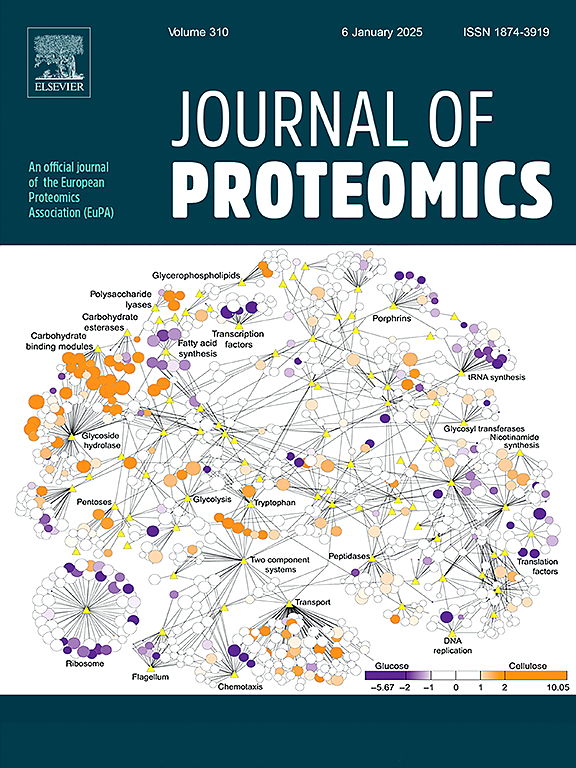Development and application of a targeted phosphoproteomics method for analysing the mTOR pathway dynamics in zebrafish PAC2 cell line
IF 2.8
2区 生物学
Q2 BIOCHEMICAL RESEARCH METHODS
引用次数: 0
Abstract
The mechanistic target of rapamycin (mTOR) signalling pathway plays a crucial role in regulating cellular growth and proliferation. While extensively studied in mammals, the phosphorylation dynamics of this pathway in non-mammalian model organisms remain largely unexplored, often due to the scarcity of suitable antibodies to measure (phosphorylated) proteins of interest. To address this gap, we developed an antibody-independent targeted phosphoproteomics method applying liquid chromatography-tandem mass spectrometry (LC-MS/MS) to quantify the abundance and phosphorylation levels of mTOR pathway-related proteins in zebrafish (Danio rerio), using the permanent cell line PAC2 as a model system. With optimized sample processing and data analysis strategies, we could successfully quantify 10 endogenous phosphosites and 15 endogenous proteins at different cell culture growth phases, revealing complex phosphorylation dynamics for both the upstream regulators (e.g., AKT, AMPK) and downstream effectors (e.g., eIF4EBP1, RPS6) of the mTOR pathway, which reflected transition from exponential growth to stationary subsistence. Our findings confirm the overall similarity of the mTOR pathway structure and functionality between zebrafish and mammals. Furthermore, this work demonstrates the high potential of the LC-MS/MS-based analytical approaches for studying phosphorylation-governed signalling in diverse organisms of interest, thus paving the way for further investigations in comparative physiology and toxicology across species.
Significance
We demonstrate the feasibility of using LC-MS/MS-based targeted phosphoproteomics to quantify protein phosphorylation dynamics of a specific pathway of interest – mTOR – in a non-mammalian model organism, zebrafish. This antibody-independent approach can enable the performance of further hypothesis-driven studies of phosphorylation-based signalling in diverse non-mammalian, non-model species. This tool could thus prove valuable for the fields of, e.g., comparative physiology and (eco)toxicology, where such investigations were previously limited due to the scarcity of suitable antibodies for specific proteins of interest in less frequently studied organisms. Moreover, thanks to the lower costs and higher throughput of targeted compared to global proteomics quantification methods, this approach can also be employed in studies aiming to validate the use of specific phosphosites as biomarkers of disease, stress or toxic chemical exposure in laboratory models or sentinel species in the environment, thus supporting future applications in toxicity testing or environmental monitoring.

斑马鱼PAC2细胞系mTOR通路动态分析的靶向磷酸化蛋白质组学方法的建立与应用。
雷帕霉素(mTOR)信号通路的机制靶点在调节细胞生长和增殖中起着至关重要的作用。虽然在哺乳动物中进行了广泛的研究,但这一途径在非哺乳动物模式生物中的磷酸化动力学在很大程度上仍未被探索,这通常是由于缺乏合适的抗体来测量(磷酸化)感兴趣的蛋白质。为了解决这一空白,我们开发了一种不依赖抗体的靶向磷酸化蛋白质组学方法,应用液相色谱-串联质谱(LC-MS/MS)来量化斑马鱼(Danio rerio)中mTOR通路相关蛋白的丰度和磷酸化水平,以永久细胞系PAC2为模型系统。通过优化样品处理和数据分析策略,我们成功地量化了10个内源性磷酸化位点和15个内源性蛋白在不同的细胞培养生长阶段,揭示了mTOR途径上游调控因子(如AKT, AMPK)和下游效应因子(如eIF4EBP1, RPS6)的复杂磷酸化动力学,反映了从指数生长到平稳生存的转变。我们的研究结果证实了斑马鱼和哺乳动物之间mTOR通路结构和功能的总体相似性。此外,这项工作证明了LC-MS/MS-based分析方法在研究多种感兴趣的生物中磷酸化调控的信号方面具有很高的潜力,从而为跨物种比较生理学和毒理学的进一步研究铺平了道路。意义:我们证明了使用LC-MS/MS-based靶向磷酸化蛋白质组学来量化非哺乳动物模式生物斑马鱼中特定途径mTOR的蛋白质磷酸化动力学的可行性。这种不依赖抗体的方法可以在多种非哺乳动物、非模型物种中进一步进行基于磷酸化信号的假设驱动研究。因此,该工具可以证明对比较生理学和(生态)毒理学等领域有价值,这些领域的研究以前受到限制,因为缺乏针对较少研究的生物体中感兴趣的特定蛋白质的合适抗体。此外,由于与全球蛋白质组学定量方法相比,靶向方法的成本更低,通量更高,因此该方法也可用于旨在验证特定磷位点在实验室模型或环境中哨兵物种中作为疾病、应激或有毒化学物质暴露的生物标志物的研究,从而支持未来在毒性测试或环境监测中的应用。
本文章由计算机程序翻译,如有差异,请以英文原文为准。
求助全文
约1分钟内获得全文
求助全文
来源期刊

Journal of proteomics
生物-生化研究方法
CiteScore
7.10
自引率
3.00%
发文量
227
审稿时长
73 days
期刊介绍:
Journal of Proteomics is aimed at protein scientists and analytical chemists in the field of proteomics, biomarker discovery, protein analytics, plant proteomics, microbial and animal proteomics, human studies, tissue imaging by mass spectrometry, non-conventional and non-model organism proteomics, and protein bioinformatics. The journal welcomes papers in new and upcoming areas such as metabolomics, genomics, systems biology, toxicogenomics, pharmacoproteomics.
Journal of Proteomics unifies both fundamental scientists and clinicians, and includes translational research. Suggestions for reviews, webinars and thematic issues are welcome.
 求助内容:
求助内容: 应助结果提醒方式:
应助结果提醒方式:


